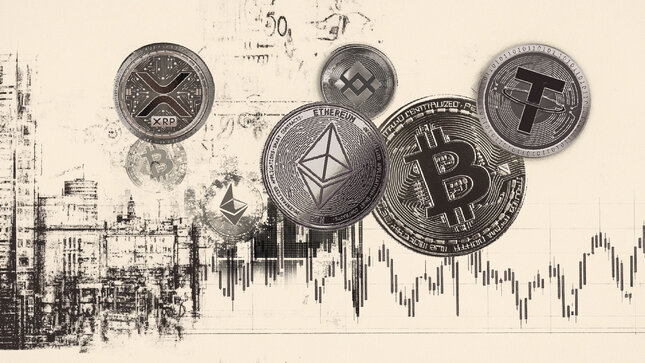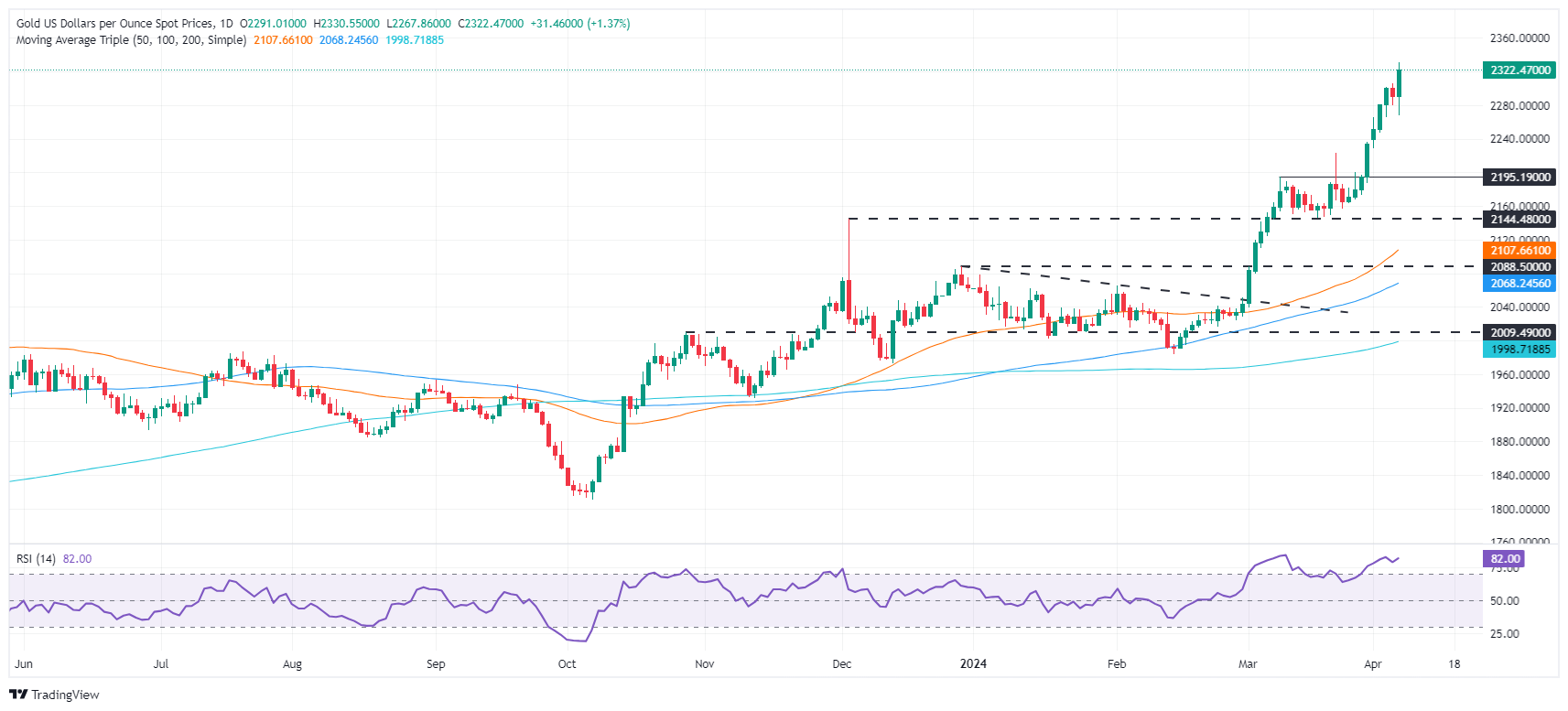- Gold hits record highs, defying US Nonfarm Payrolls spike and US Dollar gains, highlighting safe-haven status.
- Fed rate cut outlook adjusted after employment data, central bank remarks.
- Geopolitical tensions and strong demand from China bolster Gold's market strength.
Gold rallied to a new all-time high, ignoring a strong March Nonfarm Payrolls report in the United States (US), which could prevent the Federal Reserve (Fed) from slashing rates sooner than the market expects. In achieving its milestone, the yellow metal ignored the rise in US Treasury yields and the Greenback, which clings to modest gains of 0.09%.
XAU/USD trades at $2,324 after reaching $2,330 earlier in Friday’s North American session. Gold’s price continued to be driven by fundamentals linked to the US Dollar, geopolitical risks and physical demand.
Focusing on data, US Nonfarm Payrolls figures for March crushed estimates and February’s numbers as new hirings rose to 303,000. Consequently, the Unemployment Rate fell, while Average Hourly Earnings were mixed, rising on monthly figures but diving on an annual basis.
Following the data, bets that the Fed would cut rates in June fell further, from around 70% a week ago to 53.4%, according to the CME FedWatch Tool.
The employment report reinforced Fed Chair Jerome Powell’s words on Wednesday. He said they’re in no rush to cut rates, and his words echoed throughout the week. On Friday, officials crossed the wires led by Richmond’s Fed Barkin, Dallas Fed Logan and Governor Bowman.
Daily digest market movers: Gold underpinned by strong physical demand, ignores US data
- US Department of Labor announces that Nonfarm Payrolls increased by 303,000 in March, higher than the anticipated 200,000 and the previous 270,000.
- Further details revealed that the Unemployment Rate decreased modestly to 3.8% from 3.9%, with Average Hourly Earnings meeting consensus predictions. Average Hourly Earnings rose by 0.3% MoM, up from 0.2%. In the twelve months to March, earnings rose by 4.1% as expected, down from 4.3%.
- Following these figures, the US Dollar strengthened, evidenced by a 0.15% rise in the US Dollar Index (DXY) to 104.36. US Treasury bond yields increased by about 5 basis points, with the 10-year rate reaching 4.365%.
- Recently, Fed Governor Michelle Bowman stated that cutting rates too soon risks a rebound in inflation. She said that eventually, the bank would cut rates, yet inflationary risks are tilted to the upside. Earlier, Richmond Fed President Thomas Barkin described the NFP report as robust but noted that inflation reduction has been inconsistent.
- Dallas Fed President Lorie Logan said there’s “no urgency” to cut borrowing costs, adding the risk of cutting too soon is higher than being late.
- Geopolitical risks loom following Israel’s attack on Iran’s embassy in Syria. Iran pledged to retaliate against Israel after seven officers were killed. A further escalation could pressure Gold prices upward, with traders looking at the $2,350 figure.
- World Gold Consortium reveals that the People’s Bank of China was the largest buyer of the yellow metal, increasing its reserves by 12 tonnes to 2,257 tonnes.
Technical analysis: Gold’s upside set to continue despite RSI’s overbought condition
Gold’s rally is set to continue, with buyers gathering momentum. The Relative Strength Index (RSI), although at overbought conditions past the 70.00 level, aims north. Usually when an asset has a strong uptrend, the 80 reading is seen as the overbought extreme. However, as price action doesn’t show signs of exhaustion, the $2,350 mark is up for grabs.
On the flip side, the first support level would be $2,300. A breach of the latter will expose $2,250, followed by the $2,200 mark.
Gold FAQs
Gold has played a key role in human’s history as it has been widely used as a store of value and medium of exchange. Currently, apart from its shine and usage for jewelry, the precious metal is widely seen as a safe-haven asset, meaning that it is considered a good investment during turbulent times. Gold is also widely seen as a hedge against inflation and against depreciating currencies as it doesn’t rely on any specific issuer or government.
Central banks are the biggest Gold holders. In their aim to support their currencies in turbulent times, central banks tend to diversify their reserves and buy Gold to improve the perceived strength of the economy and the currency. High Gold reserves can be a source of trust for a country’s solvency. Central banks added 1,136 tonnes of Gold worth around $70 billion to their reserves in 2022, according to data from the World Gold Council. This is the highest yearly purchase since records began. Central banks from emerging economies such as China, India and Turkey are quickly increasing their Gold reserves.
Gold has an inverse correlation with the US Dollar and US Treasuries, which are both major reserve and safe-haven assets. When the Dollar depreciates, Gold tends to rise, enabling investors and central banks to diversify their assets in turbulent times. Gold is also inversely correlated with risk assets. A rally in the stock market tends to weaken Gold price, while sell-offs in riskier markets tend to favor the precious metal.
The price can move due to a wide range of factors. Geopolitical instability or fears of a deep recession can quickly make Gold price escalate due to its safe-haven status. As a yield-less asset, Gold tends to rise with lower interest rates, while higher cost of money usually weighs down on the yellow metal. Still, most moves depend on how the US Dollar (USD) behaves as the asset is priced in dollars (XAU/USD). A strong Dollar tends to keep the price of Gold controlled, whereas a weaker Dollar is likely to push Gold prices up.
Information on these pages contains forward-looking statements that involve risks and uncertainties. Markets and instruments profiled on this page are for informational purposes only and should not in any way come across as a recommendation to buy or sell in these assets. You should do your own thorough research before making any investment decisions. FXStreet does not in any way guarantee that this information is free from mistakes, errors, or material misstatements. It also does not guarantee that this information is of a timely nature. Investing in Open Markets involves a great deal of risk, including the loss of all or a portion of your investment, as well as emotional distress. All risks, losses and costs associated with investing, including total loss of principal, are your responsibility. The views and opinions expressed in this article are those of the authors and do not necessarily reflect the official policy or position of FXStreet nor its advertisers. The author will not be held responsible for information that is found at the end of links posted on this page.
If not otherwise explicitly mentioned in the body of the article, at the time of writing, the author has no position in any stock mentioned in this article and no business relationship with any company mentioned. The author has not received compensation for writing this article, other than from FXStreet.
FXStreet and the author do not provide personalized recommendations. The author makes no representations as to the accuracy, completeness, or suitability of this information. FXStreet and the author will not be liable for any errors, omissions or any losses, injuries or damages arising from this information and its display or use. Errors and omissions excepted.
The author and FXStreet are not registered investment advisors and nothing in this article is intended to be investment advice.
Recommended content
Editors’ Picks

AUD/USD: Bullish outlook seen above the 200-day SMA
AUD/USD added to Friday’s advance and came just pips away from the key 0.6500 barrier on the back of the continuation of the selling pressure in the US Dollar and renewed trade concerns.

EUR/USD looks supported just below 1.1300
EUR/USD managed to extend its bounce off last week’s troughs, advancing for the second day in a row in response to the extra downward trend in the Greenback and a broad-based risk-on sentiment among traders.

Gold moves in a consolidative fashion above $3,300
Gold adds to Friday’s advance, reclaiming the $3,300 mark per troy ounce and beyond on the back of rising safe-haven demand following heightened geopolitical tensions in the Middle East. In addition, a persistent uncertainty over US trade policy continues to linger, adding to the upside momentum in the precious metal.

Crypto Today: BTC price stumbles below $94K, SUI surges as Trump hints at Hollywood tariffs
Cryptocurrency market capitalization settled at $3.1 trillion on Monday, dipping 3% with outflows exceeding $100 billion in the last 24 hours.

Has the tariff pain peaked?
Tariff rates may have peaked, but uncertainty hasn’t: Markets may be breathing easier, but investors should not mistake easing conditions for resolution. Even if headline tariff rates stay put, the real risk lies in prolonged policy unpredictability.

The Best brokers to trade EUR/USD
SPONSORED Discover the top brokers for trading EUR/USD in 2025. Our list features brokers with competitive spreads, fast execution, and powerful platforms. Whether you're a beginner or an expert, find the right partner to navigate the dynamic Forex market.




